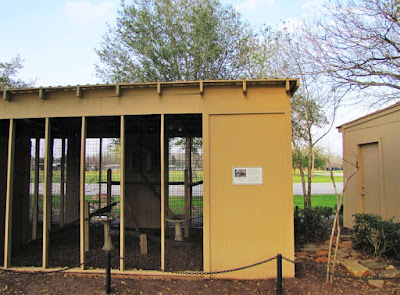Here is a pic of a pair of them; more scientifically called Polyborus plancus -- or Polybori planci, for the plural, I suppose. Oh, how I hated Latin in school, but "us" becomes "i" to form the plural of nouns, doesn't it?
These colorful inhabitants of open country and forests in South and Central America (and even parts of the US) can
be seen in captivity at the aviary at Bear Creek Park, which also features a number of other exotic birds, as well as a variety of local animals, including barred and horned owls, ducks, and farm animals such as sheep and goats. There are also two specimen of the iconic American Bison aka Buffalo.
Alas, there are no camera ports -- or even glass windows -- at the bird shed. Hence the blurry lines in the frame of the photo above, which was shot through the wire mesh. As for the birds kept in the aviary, they are in confinement because they could no longer make it on their own.
The large man-sized birds that Bear Creek Park also plays host to have their own enclosures, so they can run around and get exercise. The emus and rheas don't fly, of course, but there are also lots of native and migratory birds all around the huge park; even a flock of American Black Vultures. Well, flock may be too cute a term for these scavengers, but the should given were credit is due. Vultures help keep the park pristine, not to mention cleaning up at least some of the road-kill.
 |
| Vultures promptly dispose of carrion (meat of dead animals) and thus render a useful cleanup service because it prevents the carcasses from decaying and putrifying. |
 |
| Vultures near the pot-bellied pig pen at Bear Creek Pioneers Park |


No comments:
Post a Comment